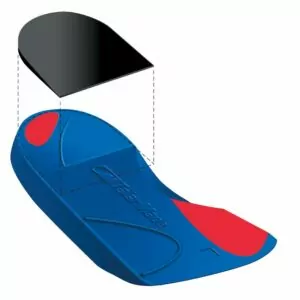Osteochondral Lesion of the Talar Dome
Updated:
(Also known as Talar Dome Lesion, Osteochondral Lesion, Osteochondral Fracture, Osteochondral Defect)
What is an osteochondral lesion of the talar dome?
An osteochondral lesion of the talar dome is a condition characterized by damage to the cartilage and / or bone surfaces of the upper (superior) aspect of the talus bone (i.e. the talar dome) in the ankle.
The ankle joint is formed by the articulation of the tibia, fibula and talus bones (figure 1). In a normal ankle, joint surfaces are smooth and there is cartilage between the bone ends which allows for efficient shock absorption and smooth movement. The small talus bone of the ankle is responsible for transferring weight bearing forces from the shin to the foot (figure 1). If these weight bearing forces are excessive and beyond what the bone can withstand, bony damage to the superior aspect of the talus and its overlying cartilage may occur (especially when combined with twisting forces or forced end of range ankle movements). This is known as an osteochondral lesion of the talar dome and can range from bruising of the cartilage to a complete fracture of the talus. Occasionally a bony fragment may separate from the talus and float within the ankle joint.
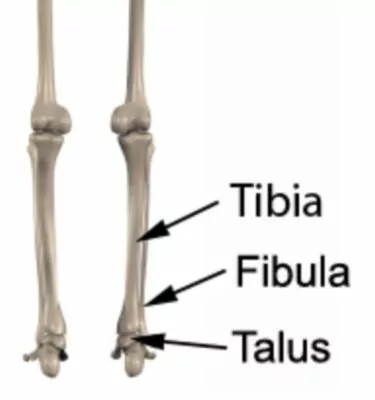
Causes of an osteochondral lesion of the talar dome
An osteochondral lesion of the talar dome typically occurs during a traumatic injury to the ankle, such as an ankle sprain (particularly involving significant weight bearing forces), a traumatic landing from a height (particularly involving forced end of range ankle movements) or a motor vehicle accident. It may also be more common in those patients with poor foot biomechanics or inappropriate footwear.
Signs and symptoms of an osteochondral lesion of the talar dome
Patients with this condition typically experience deep ankle pain (usually at the front of the ankle) that increases with weight bearing and twisting activities, such as standing, walking and running excessively (especially on hard or uneven surfaces, or up or down hills or stairs), jumping and landing, lifting and carrying heavy objects and change of direction sports or activities. It is also common for symptoms to increase after activity with rest (especially at night or upon waking the following morning). Symptoms usually vary depending on the severity of injury and may include: pain (around the ankle), swelling, stiffness, pain on firmly touching the talus bone (usually at the front of the ankle – figure 1) and occasionally clicking, catching or locking of the ankle. In more severe cases, patients may walk with a limp or may be unable to weight bear due to pain.
Diagnosis of an osteochondral lesion of the talar dome
A thorough subjective and objective examination from a physiotherapist is important in diagnosing an osteochondral lesion of the talar dome. Investigations such as an X-Ray, MRI, CT scan or bone scan are usually required to confirm the diagnosis and rule out other pathologies.
Treatment for an osteochondral lesion of the talar dome

Members Only ContentBecome a PhysioAdvisor Member to gain full access to this exclusive content. For more details see Become a Member. Already a member? Login Now
Prognosis for an osteochondral lesion of the talar dome
Patients with this condition usually make a full recovery with appropriate management (whether surgical or conservative). Return to activity or sport can usually take place in a number of weeks to many months and should be guided by the treating physiotherapist and specialist. In patients with severe injuries involving damage to other bones, soft tissue, nerves or blood vessels, recovery time may be significantly prolonged. All patients with an osteochondral lesion of the talar dome may have an increased likelihood of developing arthritis of the ankle, particularly in those with more severe injuries, those who require surgery or those who do not complete a high quality rehabilitation program.
Physiotherapy for an osteochondral lesion of the talar dome
Physiotherapy treatment is vital for all patients with an osteochondral lesion of the talar dome to hasten the healing process, ensure an optimal outcome and reduce the likelihood of recurrence. Treatment may comprise:
- soft tissue massage
- joint mobilization
- dry needling
- electrotherapy (e.g. ultrasound)
- the use of crutches, a walking stick or other walking aid
- the use of a protective boot
- ankle taping, Achilles tendon taping or arch support taping
- ankle bracing
- the use of heel wedges
- the use of a compression bandage
- ice or heat treatment
- exercises to improve flexibility, strength, core stability and balance
- hydrotherapy
- education
- activity and lifestyle modification advice
- biomechanical correction
- prescription of orthotics or footwear advice
- a gradual return to activity program
- a gradual return to running program
- anti-inflammatory and supplement advice (e.g. fish oil, glucosamine and chondroitin)
- weight loss advice where appropriate
Contributing factors to the development of an osteochondral lesion of the talar dome
There are a number of factors that may increase the likelihood of this condition occurring. These factors need to be assessed and corrected (where possible) with direction from a physiotherapist to ensure an optimal outcome and may include:
- muscle weakness (particularly of the calf, peroneals, quadriceps and gluteals)
- muscle tightness (e.g. calf)
- poor core stability or balance
- being overweight
- poor nutrition or inappropriate diet
- a sedentary lifestyle
- joint stiffness
- poor foot posture (e.g. flat feet)
- inappropriate footwear
- excessive weight bearing or twisting activities
- participation in high impact/velocity landing sports (e.g. snow skiing, snowboarding, gymnastics)
- fatigue
- inappropriate surfaces for training or activity
- inadequate warm up
Other intervention for an osteochondral lesion of the talar dome
Despite appropriate physiotherapy management, a small percentage of patients with this condition do not improve adequately. When this occurs the treating physiotherapist or doctor can advise on the best course of management. This may involve further investigation such as an X-ray, CT scan, MRI or bone scan, pharmaceutical intervention, corticosteroid injection, the use of supplements such as fish oil, glucosamine and chondroitin or a review by a specialist who can advise on any procedures that may be appropriate to improve the condition. Surgery, plaster cast immobilisation, the use of crutches or a protective boot may be indicated in patients with more severe injuries or in those cases that are unresponsive to conservative measures. A review with a podiatrist may also be indicated for the prescription of orthotics and appropriate footwear advice.
Exercises for an osteochondral lesion of the talar dome
The following exercises are commonly prescribed to patients with this condition. You should discuss the suitability of these exercises with your physiotherapist prior to beginning them. Generally, they should be performed 2-3 times daily once the physiotherapist and/or orthopaedic specialist have indicated it is safe to do so and only provided they do not cause or increase symptoms.
Your physiotherapist can advise when it is appropriate to begin the initial exercises and eventually progress to the intermediate and advanced exercises. As a general rule, addition of exercises or progression to more advanced exercises should only take place provided there is no increase in symptoms.
Initial Exercises
Foot and Ankle Up and Down
Move your foot and ankle up and down as far as you can go without pain and provided you feel no more than a mild to moderate stretch (figure 2). Repeat 10 – 20 times provided the exercise is pain free.
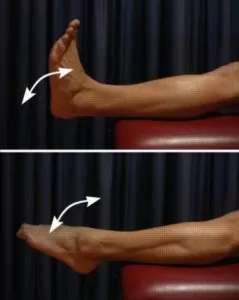
Foot and Ankle In and Out
Move your foot and ankle in and out as far as you can go without pain and provided you feel no more than a mild to moderate stretch (Figure 3). Repeat 10 – 20 times provided the exercise is pain free.
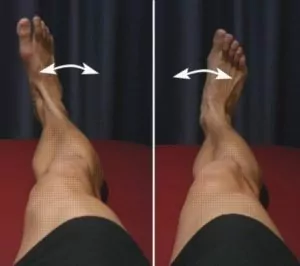
Calf Stretch with Towel
Begin this stretch in long sitting with your leg to be stretched in front of you. Your knee and back should be straight and a towel placed around your foot as demonstrated (figure 4). Using your foot, ankle and the towel, bring your toes towards your head as far as you can go without pain and provided you feel no more than a mild to moderate stretch in the back of your calf, Achilles tendon or front of your ankle. Hold for 5 seconds and repeat 10 times at a mild to moderate stretch provided the exercise is pain free.

Intermediate Exercises

Members Only ContentBecome a PhysioAdvisor Member to gain full access to this exclusive content. For more details see Become a Member. Already a member? Login Now
Advanced Exercises

Members Only ContentBecome a PhysioAdvisor Member to gain full access to this exclusive content. For more details see Become a Member. Already a member? Login Now
Other Exercises

Members Only ContentBecome a PhysioAdvisor Member to gain full access to this exclusive content. For more details see Become a Member. Already a member? Login Now
Rehabilitation Protocol for an osteochondral lesion of the talar dome

Members Only ContentBecome a PhysioAdvisor Member to gain full access to this exclusive content. For more details see Become a Member. Already a member? Login Now
Physiotherapy products for an osteochondral lesion of the talar dome
Some of the most commonly recommended products by physiotherapists for patients with this condition include:
-
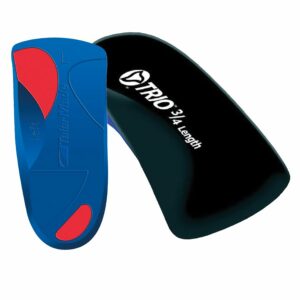 Talar Made TRIO Orthotics (3/4 length)
Talar Made TRIO Orthotics (3/4 length) -
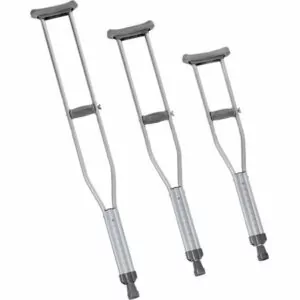 Aluminium Underarm Adjustable Axillary Crutches
Aluminium Underarm Adjustable Axillary Crutches -
 Forearm Crutches Adjustable – Standard Grip
Forearm Crutches Adjustable – Standard Grip -
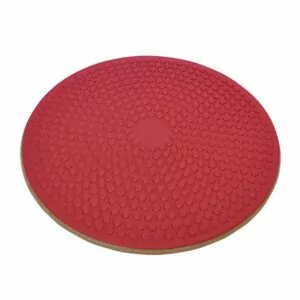 AllCare Wobble Board (Red – ACWOBRD)
AllCare Wobble Board (Red – ACWOBRD) -
 AllCare Band
AllCare Band -
 Premium Strapping Tape 38mm (Victor)
Premium Strapping Tape 38mm (Victor) -
 Fixomull Stretch 5cm x 10m
Fixomull Stretch 5cm x 10m -
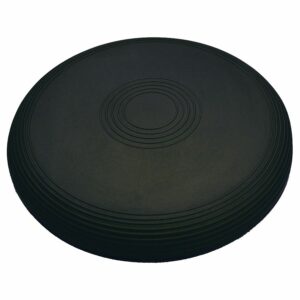 Lournet Stability Dura Disc
Lournet Stability Dura Disc -
 AllCare Ortho Standard Walker (Cam Boot)
AllCare Ortho Standard Walker (Cam Boot) -
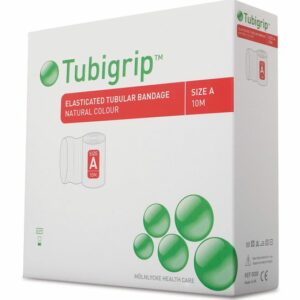 Tubigrip
Tubigrip -
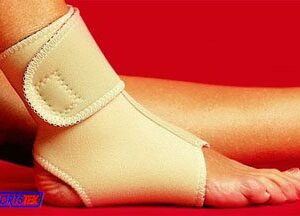 Thermoskin Heat Retaining Ankle Wrap
Thermoskin Heat Retaining Ankle Wrap -
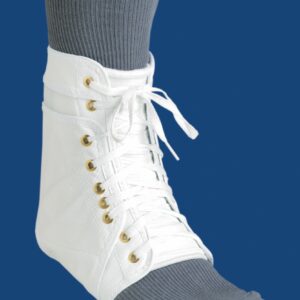 Swede-O Lace Up Ankle Brace
Swede-O Lace Up Ankle Brace
To purchase physiotherapy products for an osteochondral lesion of the talar dome, click on one of the above links or visit the PhysioAdvisor Shop.
Find a Physio for an osteochondral lesion of the talar dome
Find a physiotherapist in your local area who can treat an osteochondral lesion of the talar dome.
 More Exercises
More Exercises
- Ankle Stretches.
- Ankle Strengthening Exercises.
- Balance Exercises.
- Leg Stretches.
- Leg Strengthening Exercises.
- Cardiovascular Exercise.
- Lower Body Machine Weights
- Massage Ball Exercises
- Foam Roller Exercises
- Core Stability Exercises
 Recommended Reading
Recommended Reading
- How to use Crutches
- Ice or Heat?
- The R.I.C.E. Regime
- Choosing a Shoe
- Do I Need Orthotics?
- Ankle Taping
- Achilles Tendon Taping
- Arch Support Taping
- Return to Running Program
- Return to Sport
- Warming up and Cooling Down
- Injury Prevention
- Ankle Diagnosis Guide
Become a PhysioAdvisor Member
-
 Individual Membership (12 Months)$59.95 for 1 year
Individual Membership (12 Months)$59.95 for 1 year -
 Individual Membership (3 Months)$39.95 for 3 months
Individual Membership (3 Months)$39.95 for 3 months -
 Individual Membership (Yearly)$49.95 / year
Individual Membership (Yearly)$49.95 / year -
 Individual Membership (Monthly)$15.95 / month
Individual Membership (Monthly)$15.95 / month

Link to this Page
If you would like to link to this article on your website, simply copy the code below and add it to your page:
<a href="https://physioadvisor.com.au/injuries/ankle/osteochondral-lesion-of-the-talar-dome”>Osteochondral Lesion of the Talar Dome – PhysioAdvisor.com</a><br/>PhysioAdvisor offers detailed physiotherapy information on an osteochondral lesion of the talar dome including: causes, signs and symptoms, diagnosis, treatment, exercises, rehabilitation protocol, physiotherapy products and more...
Return to the top of Osteochondral Lesion of the Talar Dome.

